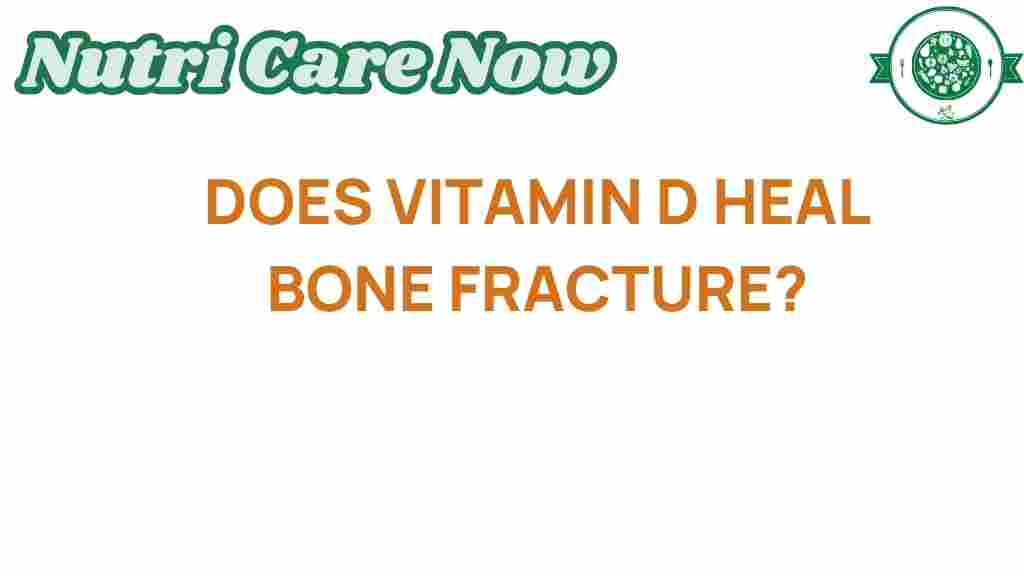Unraveling the Mystery: Does Vitamin D Heal Bone Fractures?
Bone health is a crucial aspect of overall well-being, especially as we age. Among the various nutrients essential for maintaining strong bones, Vitamin D stands out for its significant role in calcium absorption and bone metabolism. In this article, we will explore the relationship between Vitamin D and bone fractures, examining the healing process, the health benefits, and the impact of nutrition and supplements on bone health.
The Role of Vitamin D in Bone Health
Vitamin D is a fat-soluble vitamin that plays a vital role in maintaining bone health. It aids in the absorption of calcium and phosphorus, two minerals that are essential for building and maintaining strong bones. Without adequate Vitamin D, the body cannot absorb enough calcium, leading to weakened bones and an increased risk of fractures.
How Does Vitamin D Help in Healing Bone Fractures?
When a bone fractures, the healing process begins immediately. Vitamin D contributes to this healing in several ways:
- Calcium Absorption: As mentioned, Vitamin D enhances the body’s ability to absorb calcium, which is critical for the formation of new bone tissue.
- Bone Remodeling: Vitamin D is involved in the bone remodeling process, where old bone is replaced with new bone. This process is essential for healing fractures.
- Regulating Bone Cells: Vitamin D helps regulate the activity of osteoblasts (bone-building cells) and osteoclasts (bone-resorbing cells), maintaining a healthy balance necessary for bone repair.
Health Benefits of Vitamin D Beyond Bone Fractures
While the focus here is on bone fractures, Vitamin D offers many other health benefits:
- Immune Function: Vitamin D plays a role in enhancing the immune system, helping the body fight off infections.
- Mood Regulation: Adequate levels of Vitamin D have been linked to improved mood and a lower risk of depression.
- Cardiovascular Health: Some studies suggest that Vitamin D may contribute to heart health by regulating blood pressure and inflammation.
Understanding Osteoporosis and Vitamin D
Osteoporosis is a condition characterized by weak and brittle bones, making fractures more likely. This condition is particularly prevalent in older adults and postmenopausal women. Vitamin D is crucial in the prevention and management of osteoporosis for the following reasons:
- Improved Bone Density: Vitamin D helps maintain and even improve bone density, reducing the risk of fractures.
- Prevention of Falls: By improving muscle strength and balance, Vitamin D can help prevent falls, which are a common cause of fractures in the elderly.
Nutrition and Sources of Vitamin D
To support bone health and aid in the healing of bone fractures, it is essential to incorporate Vitamin D into your diet. Here are some dietary sources of Vitamin D:
- Fatty Fish: Salmon, mackerel, and sardines are excellent sources of Vitamin D.
- Fortified Foods: Many dairy products, juices, and cereals are fortified with Vitamin D.
- Egg Yolks: Eggs are another dietary source of Vitamin D.
In addition to dietary sources, sunlight exposure is a natural way for the body to produce Vitamin D. Spending time outdoors, especially in the sun, can help increase your Vitamin D levels.
Vitamin D Supplements for Bone Health
If you are unable to get enough Vitamin D from food or sunlight, supplements may be a beneficial option. Here’s what you need to know about Vitamin D supplements:
- Types of Supplements: Vitamin D3 (cholecalciferol) is the preferred form as it is more effective in raising Vitamin D levels in the blood compared to Vitamin D2 (ergocalciferol).
- Dosage: The recommended daily allowance for adults is 600 to 800 IU, but higher doses may be necessary for those with low blood levels of Vitamin D.
- Consultation: Always consult with a healthcare provider before starting any supplementation, especially if you have existing health conditions or are taking other medications.
Step-by-Step Process for Ensuring Adequate Vitamin D Intake
To optimize your bone health and aid in the healing of bone fractures, follow these steps:
- Assess Your Vitamin D Levels: Get your Vitamin D levels checked through a blood test, especially if you have risk factors for deficiency.
- Adjust Your Diet: Incorporate Vitamin D-rich foods into your meals. Aim for a balanced diet that includes dairy, fatty fish, and fortified products.
- Get Sunlight: Spend at least 15-30 minutes in the sun several times a week, ensuring to expose your arms and legs for maximum absorption.
- Consider Supplements: If dietary intake and sunlight exposure are insufficient, consider taking Vitamin D supplements as advised by a healthcare professional.
Troubleshooting Tips for Vitamin D Deficiency
If you find yourself struggling with Vitamin D deficiency, here are some troubleshooting tips:
- Monitor Your Intake: Keep a food diary to track your Vitamin D consumption and identify gaps in your diet.
- Adjust Sun Exposure: If you live in a region with limited sunlight, consider using a light therapy box or taking a vacation to a sunnier location.
- Review Medications: Certain medications can interfere with Vitamin D metabolism. Speak with your doctor to evaluate your current medications.
Conclusion: The Importance of Vitamin D in Healing Bone Fractures
In conclusion, Vitamin D plays a critical role in bone health and the healing of bone fractures. Its ability to enhance calcium absorption and support bone remodeling makes it an essential nutrient for maintaining strong bones, especially for those at risk of osteoporosis. Incorporating adequate Vitamin D through diet, sunlight, and supplements can help you achieve optimal bone health and overall wellness.
For more information about bone health and nutrition, check out this resource. Remember, always consult with a healthcare professional before making significant changes to your diet or supplement regimen.
By prioritizing your Vitamin D intake, you can support your healing process and protect your bones for a healthier future.
This article is in the category Health and created by NutriCareNow Team
